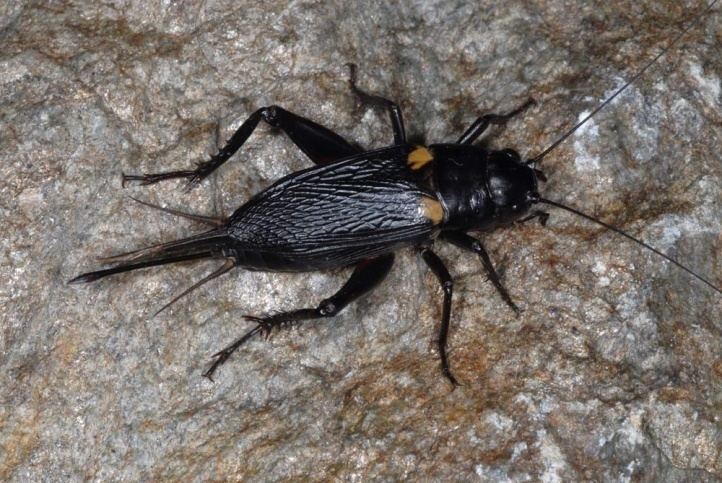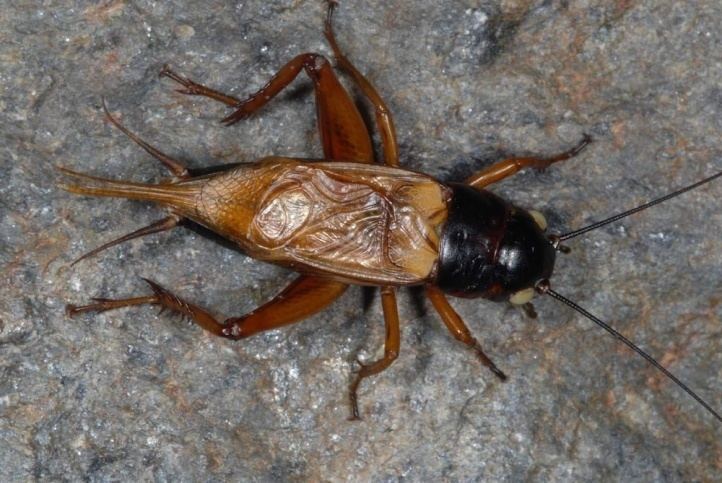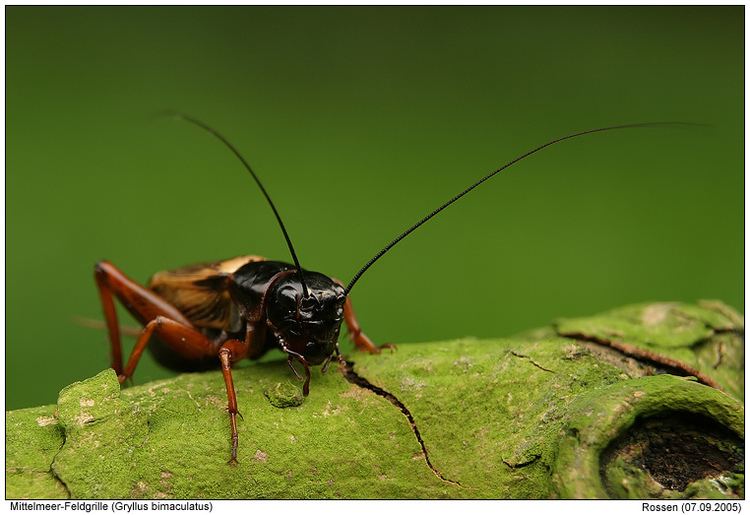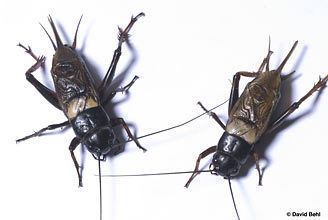Family Gryllidae Higher classification Gryllus | Genus Gryllus Rank Species | |
Similar Gryllus, Cricket, Insect, Field cricket, House cricket | ||
Gryllus bimaculatus is one of many cricket species known as field crickets. Also known as the African or Mediterranean field cricket or as the two-spotted cricket, it can be discriminated from other Gryllus species by the two dot-like marks on the base of its wings.
Contents
- Gryllus bimaculatus kampf
- Fighting
- Chirping
- Shelter
- Cannibalism
- Circadian Rhythm
- Breeding
- Polygamy
- Polygamy in Males
- Polyandry
- Economic importance
- References

The species is popular for use as a food source for insectivorous animals like spiders and reptiles kept as pets or in zoos. They are easy to raise and do not require prolonged exposure to cold in order to complete their life cycle.

Gryllus bimaculatus kampf
Fighting

In the wild, male crickets do not tolerate one another and will fight until there is a winner. The loser usually retreats without serious injury. The fighting method involves opening the mandibles as wide as possible, gripping the opponent's mandibles and pushing with the hind legs.
Chirping

Male crickets of this species produce several distinctive chirps, though each sound is made by rubbing the two outer wings together. Loud and steady chirps made throughout the night are to attract females and to warn off other males. Loud fast-frequency chirps are emitted when males encounter one another and are preparing to fight. They are intended to frighten off the rival male. A soft clipping sound is made when a female is known to be nearby. Its purpose is to encourage the female to mate.
Shelter
These crickets can be found hiding under logs, grasses, and in crevices. They can also dig holes into the ground to create homes for themselves, or live in holes created by other animals. Males are territorial and will fight off other males, but allow any number of females to coexist in the same shelter.
Cannibalism
Cannibalism is extremely rare, but females have been observed to eat males if there is not enough food to eat.
Circadian Rhythm
Pigment Dispersing Factor has been implicated in the nocturnal rhythms of crickets.
Breeding
Females have a tubular organ at the rear, known as an ovipositor, which is used to lay eggs into the ground. They lay their eggs into humid soil and the baby crickets hatch in about two weeks.
Polygamy
Gryllus bimaculatus exhibit polygamy, in which one individual has many different mates. Variation of polygamous behavior occurs between males and females, within a population of Gryllus bimaculatus. Both females and males continuously seek mates with whom they can spread their seed. Polyandry is the most common form of polygamy practiced in G. bimaculatus. This means that female crickets will mate with more than one male. Male crickets do not exhibit polygyny.
Polygamy in Males
The rate at which males seek mates is unspecific but relatively high. This is due to anisogamy and their drive to pass on alleles while minimizing competition.
Males will show the same drive to mate with previous mates as with new mates. The ability of a male cricket’s sperm to successfully fertilize a female’s egg after mating varies depending on various traits. An example of one trait that increases fertilization success is the amount of sperm that is effectively delivered through mating. The more sperm that is deposited results in greater fertilization success because more eggs are able to hatch. The order in which various males mate with one female before fertilization also affects fertilization success. The last male that mates with a female tends to have the highest fertilization success. Traits that increase the ability of a male’s sperm to successfully fertilize a female’s egg compared to that of another male are most advantageous. This is because these traits have been selected for over traits that have lower fertilization success.
Polyandry
Females prefer to mate with certain males more than others. Females show a distinct preference for mating with new males. Female G. bimaculatus mate with at least two males before zygote production occurs.
Polyandry is a costly reproductive system for females because they put a lot of time, energy and resources into producing eggs. It is not as costly for males because they can produce a larger amount of sperm for less time, energy and resources. Males can also fertilize many eggs in one mating. However, polyandry is still evolved in crickets because it provides benefits that outweigh the costs. It allows females to mate with males that have more desirable traits than previous mates, which is beneficial to offspring success. This multiple mate system allows new combinations of genes to come together, which results in more genetic variation in the population. It also allows females to avoid mating with infertile males. Two mechanisms that allow polyandry to be advantageous agents for increasing males' fitness are sperm competition and male guarding behavior.
Sperm Competition
Sperm competition is the interaction between sperm traits and female selection of these traits. It allows males with more advantageous traits to survive and reproduce more than less fit males. In particular, competition among males causes sperm competition to increase. Sperm expenditure will increase when there is a higher risk of competition. Reproductive investment is metabolically straining, especially for males that have less desirable genes. These males have to invest even more resources into each reproductive opportunity when a mate competitor is in their environment. The amount of resources a male invests in producing a large amount of sperm, the greater the chances of successful fertilization.
Sperm competition also helps to prevent crickets that have genomes that are too similar from mating. Inbreeding , which is when individuals who are have closely related genomes mate, decreases the viability of cricket offspring and results in offspring with lower fitness. As a result, male crickets that are genetically similar to female mates tend to be less effective in producing healthy offspring that have high fitness. Females can avoid the costs of inbreeding by selecting sperm that are not genetically similar to their eggs.
Male Guarding Behavior
Male guarding behaviors are when male crickets guard female crickets after recently mating with them. These behaviors protect the guarding male’s sperm and allow this sperm to fertilize the female’s egg, despite the increase in predation of the guarding male. As a result, the guarding male’s advantageous traits are passed on. Male guarding behaviors also reduce the risk of females becoming prey. When males protect female mates from predators, these females are saved from death. This not only has the benefit of allowing that particular male’s sperm to become fertilized, but also allows the female to continue to survive and reproduce. This in turn can lead to increased mating and higher fitness between the female and guarding male.
Novel Mate Hypothesis
Females of G. bimaculatus species prefer to mate with new, or "novel", mates. The Novel Mate hypothesis states that a female will avoid mating with males they have already mated with. The differentiation between previous mates and novel ones allows females to search for genetically superior males.
Females are able to differentiate between novel and previous mates through odor cues. These are left behind by the female on the male to allow for sensory-differentiation. This self-referent chemosensory signaling is both a reliable and simple means for a female to maximize the benefits of polyandry. Females can also use palpation and antennation before mating to deduce whether or not a mate is novel.
Economic importance
Gryllus bimaculatus is widely used by suppliers of live crickets for feeding to pet and zoo animals.
